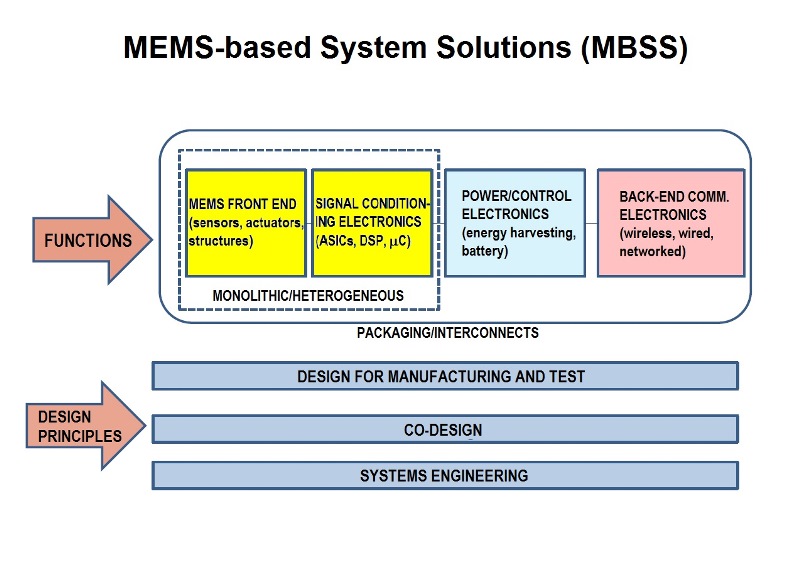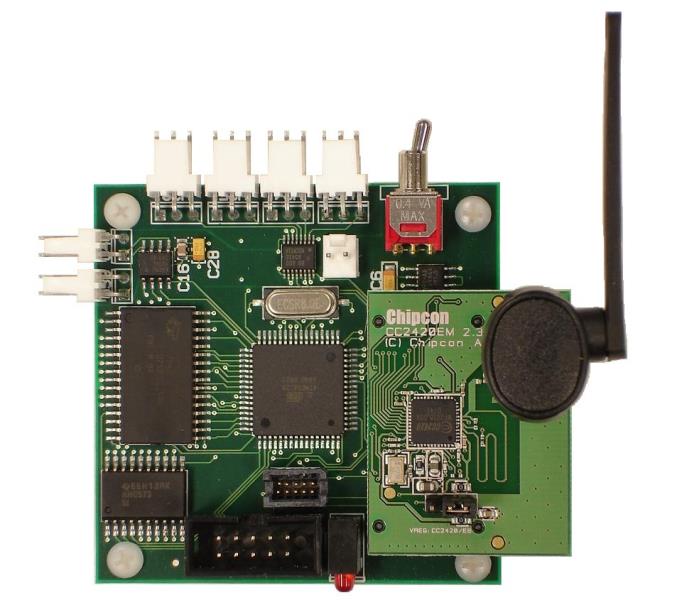By ROGER H. GRACE
President,
Roger Grace Associates
www.rgrace.com
MEMS-based systems solutions (MBSS) are systems that use sensor-based measurements to provide actionable data to autonomously control real-world conditions. The major functions needed to realize MBSS include a sensor front end, low-power signal conditioning electronics (typically an ASIC including a microcontroller with embedded algorithms), power supply/storage/management, back-end wireless communications, and antennas. All of this is enclosed in a package (Fig. 1 ).

Fig. 1: MEMS-based systems solutions (MBSS) integrate critical elements of the Internet of Things (IoT) including sensing, computing and communications to provide valuable measurements capability for Smart Building/Smart Transport monitoring and control applications.
The good news is that all of the hardware for the realization of MBSS to support Internet-of-Things (IoT) applications is virtually off the shelf, with the exception of the package and an energy system (batteries are frequently being used for this purpose, sometimes in conjunction with energy harvesting).
However, the challenge to create a commercializable solution lies in the ability to realize an MBSS solution that meets the application’s requirements in a robust, cost- effective manner. System integration and the ability to create effective algorithms that produce required functionalities are the key.
I am one of many who believe that one of the major opportunities associated with IoT is in so called Smart Buildings and Smart Transport. Here we will address several of the more interesting Smart Buildings/Smart Roads implementations. The focus will be on the front -end sensors since, without them, the ability to measure vital parameters (including strain and vibration) needed for data acquisition and control would not be possible.
Smart Transport
Smart transport is another major IoT opportunity for MBSS. Major drivers for the adoption of these systems are vehicle, passenger and pedestrian safety; convenience; fuel efficiency and reduction of environmental pollution. Not only are sensors being implemented in large numbers for vehicles (not to be covered in this article)…but in the roadways, tunnels, bridges and train tracks that are ubiquitous in our overall transport infrastructure.
Libelium (www.libelium.com) has designed and installed a system of sensor platforms that will measure the presence or absense of parked vehicles. As part of the European Framework 7 Program, the company has instrumented a 1,000 node system in Santandar Spain that uses their Waspmote open system architecture platform. The 400 node parking monitoring system includes magnetic sensors, signal conditioning electronics, 7-10 year life battery and a radio in a 12 cm. diameter package. The measured information is transmitted to an access point on a nearby lamp post and the data then gets transmitted to the cloud and processed. The processed data is sent to the parking department headquarters where it gets analyzed and then sent to displays on the street as well as to mobile phones/tablets/computers to direct vehicles to the appropriate available parking spots.
Additionally, another 600 node system is mounted on lamp posts and uses CO2 sensors to measure air quality, as well as light level sensors to measure the ambient light that will control the street light illumination.
Sensys Networks (www.sensysnetworks.com) has developed a similar magnetic sensor based system for use in traffic intersections. The system consists of a three-axis magnetometer, signal conditioning electronics with embedded software, and a radio, all in a 3 x 3x 3-in. package that is embedded in arterial roadways and intersections (Fig.2 ). They are a lower cost solution than the large, six foot diameter magnetic loops that proliferate in roadways today and which they are expected to replace. Information about vehicle presence is transmitted to a collecting platform and transmitted to the cloud for processing and traffic light management and control.

Fig. 2: Smart Transport applications include traffic lane monitoring, intersection monitoring for vehicles and bike lane/intersection monitoring as well as parking space occupancy status. Magnetic sensors are the sensor of choice for vehicle detection and radar sensors for pedestrian and bicycle detection. (Graphic courtesy of Sensys Networks)
Prof. Jerry Lynch, University of Michigan has used “Narada” sensor nodes to determine a bridge’s structural status under dynamic conditions on two bridges: the Monroe Michigan Telegraph Road Bridge and the New Carquinez California Bridge. In 2011, the New Carquinez Bridge (which is on Route I-80 in Vallejo, CA) had 31 wireless sensor nodes deployed on its 1056-meter structure. A total of 87 channels of tri-axis accelerometers, strain gages, wind velocity, temperature and potentiometer displacement sensors are measured using his proprietary Narada 4 x 4 inch pc board platform, which can accept up to four channels of sensor data (Fig. 3 ). The purpose of the deployment, states Prof. Lynch, “was to determine the cost-effective deployment and robustness of the Narada sensor nodes and their remote sensors.” Data taken by the system will be used to validate the models developed by the WIMSS team and will be used to better understand the response of the bridge under conditions including high wind loading and earthquakes.
Fig. 3: The NARATA wireless node was developed for structural health monitoring applications. The node is 4 x 4 in. and contains an 8-bit embedded microcontroller, 128-kB flash memory, 128-kB RAM, four 16-bit ADC channels, two 12-bit DAC channels, and a power amplified IEEE802.15.4 radio. (Photo courtesy of University of Michigan WIMSS)
Additionally, Prof. Bill Spencer of the University of Illinois Urbana-Champagne (http://shm.cs.uiuc.edu/) and his team have instrumented the Jindo Island Bridge in Korea. Here 113 nodes (reported to be the largest deployment of its type for bridge monitoring) have been deployed over the 344 meter span.
Smart Buildings
Smart Buildings provide their occupants with a quality and comfortable work environment, increased safety and security while operating in an energy efficient fashion. One of the more interesting applications for home use is the Nest “learning” thermostat (www.nest.com). The “learning” thermostat consists of seven sensors (none of which are MEMS-based) including ones that measure temperature and humidity as well as presence sensors that determine the status of occupancy of the home. The unique feature of the $249 product is its ability to intelligently program the heating/cooling system of a home based on occupant usage history.
The Bob and Betty Beyster Computer Science Building at the University of Michigan has recently been instrumented by Prof. Jerry Lynch of the Center for Wireless MicroSensing and Systems (www.wims2.org) with 15 “Martlet” wireless sensor nodes consisting of a total of 45 channels of temperature, humidity, and CO2 sensors. The objective of the project is to “deploy a sensor network and model the environmental conditions as they relate to HVAC performance. The next steps include monitoring occupant’s behavior/presence and connecting the network directly to the control system of the HVAC system to achieve optimum performance versus cost” stated Prof. Lynch.
The preceding interesting implementation of MBSS have been in operation and demonstrated their viability over the past several years. Based on the research I’ve conducted on the adoption of these IoT solutions, it is apparent that funding for these projects appears to be the major barrier to their widespread adoption.
With the shortfalls of municipal, state, and federal highway budgets, it will be difficult to realize widespread adoption of smart transport systems without strong financial justification. For smart buildings, again the question is who will pay for smart sensor-based systems…the building owners? What motivations exist? Certainly reducing energy cost and carbon footprint are two important factors.
About the Author

Roger H. Grace is president of Roger Grace Associates, a Naples Florida -based strategic marketing consulting firm specializing in high technology, which he founded in 1982. His background includes over 45 years in high-frequency analog circuit design, application engineering, project management, product marketing, and technology consulting. His clients include the international “Who’s Who” of corporations, federal laboratories, and government agencies.
Mr. Grace has specialized in sensors and integrated circuits for over 35 years with a focus on microelectromechanical systems (MEMS) and is considered a pioneer in this field. He has authored over 60 technical papers; organized, chaired, and spoken at over 30 international technical sessions; contributed over 30 technical feature articles; and is frequently quoted as an industry expert in major international technical and business publications.
He was selected as a recipient of the Outstanding Engineering Alumni of the Year in 2004 by Northeastern University. Mr. Grace held the position of visiting lecturer at the University of California at Berkeley from 1990 to 2003. His educational background includes a B.S.E.E. and M.S.E.E. (as a Raytheon Company fellow) from Northeastern University, and the MBA program at Haas Graduate School of Business at U.C. Berkeley.
Advertisement
Learn more about Roger Grace Associates





